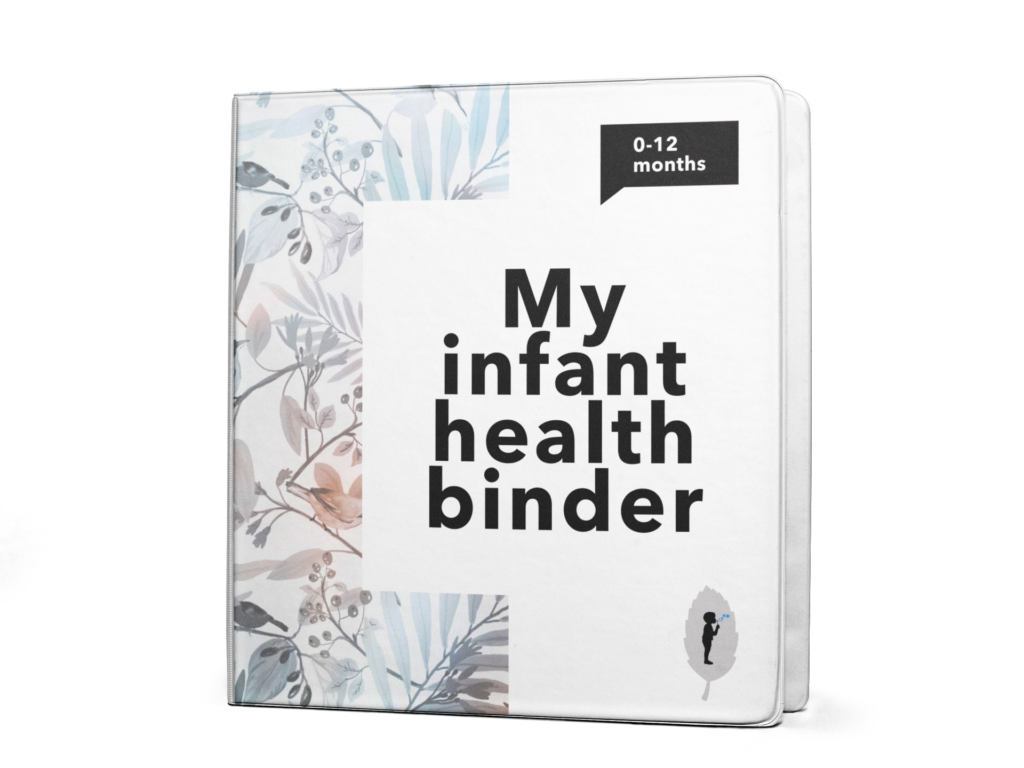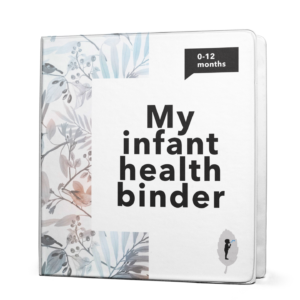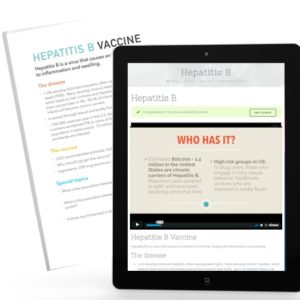How to Tell if Your Breastfed Baby Has a Food Allergy
Nutrient Allergies and Breastfeeding: Is my baby reacting to something I'm eating?

My baby is exclusively breastfed and has never eaten solids, simply seems to react to my milk. What could be causing it?
Proteins from the foods you swallow are passed to your babe through your breastmilk and may be causing an allergic or hypersensitivity reaction. The foods that nearly commonly cause these reactions in young children are cow's milk, eggs, peanuts, gluten, soy, tree nuts, corn, fish, and shellfish. The allergies show up as digestive issues, pare rashes, and respiratory concerns, and ofttimes with multiple symptoms at once.one,2 If you or close family unit members have nutrient allergies, your baby is more probable to have them as well.two
This post will provide you with resources to eliminate allergenic foods from your diet to find out if they're causing your piffling one discomfort. Later you will examination the foods to come across if your babe has outgrown the reaction. Well-nigh babies outgrow these early food reactions somewhere between the ages of 1-three.ane,ii We recommend doing the Emptying / Challenge Diet under the supervision of a Naturopathic Dr., every bit we are extensively trained and experienced in the areas of diet and nutrition.
There are unlike types of immune reactions your baby might exist having when reacting to allergenic foods. The rarest, but most serious, is a true allergy (IgE-mediated), which happens within 2 hours of eating and can result in anaphylaxis, a potentially life-threatening status. More than normally, it is a delayed sensitivity reaction that causes Gastrointestinal symptoms like loose stools, diarrhea, bloody stools, constipation, abdominal hurting (colic), vomiting, and reflux.2 Sensitivity reactions occur within a couple of hours to a couple of days of exposure to an allergenic nutrient. While they are not life-threatening, sensitivity reactions can increase inflammation in the gut, alter the immune cells of babies, and increment Immunogloblin K (IgG) for the specific foods.2,3,4 Read our not bad commodity about the different types of allergic and sensitivity reactions for more details.
Symptoms of food allergies and sensitivities:
- Anaphylaxis Symptoms: Difficulty Swallowing, Difficulty Animate, Hives, Swelling and puffiness of the lips and eyes, Diarrhea, Airsickness, Intestinal Pain, Itchy Mouth.
- Symptoms of a Nutrient Sensitivity:*
- Gastrointestinal Symptoms: Loose Stools, Diarrhea, Constipation (with possible rash around anus), Lack of Ambition, Failure to Thrive, Reflux, Colic / Irritability, Vomiting, Encarmine Stool (and subsequent Iron deficiency), Food poly peptide-induced enterocolitis syndrome (FPIES): daze-like symptoms with vomiting and diarrhea.
- Respiratory Symptoms: Runny Olfactory organ, Chronic Cough, Asthma, Wheezing or shortness of breath, Frequent colds and flu, Recurring Ear Infections.
- Skin Symptoms: Eczema, Hives, Rashes.
*Based on signs and symptoms of Cow's Milk Allergy (CMA), a term that refers to both IgE-mediated allergies and non-IgE-mediated sensitivities to casein and whey proteins in cow's milk.1,2,3
Why does everyone remember the problem is dairy?
When you talk about your baby's Colic, Eczema, or Ear Infections to friends and family, they might suggest that dairy is causing the result. The reason for this is that Cow's Milk Allergy (CMA) is the nigh common food allergy in young children, and has been studied more than whatever other food allergy. Approximately 2-8% of formula-fed babies and 0.5% of breastfed babies experience Moo-cow'south Milk Allergy.five,6,seven Since food allergies are on the rise and are believed to be nether-reported and nether-diagnosed, these numbers may actually be higher.ane,8 In breastfed babies, the about mutual symptoms of a milk allergy are eczema and bloody stools.2,6,10Removing dairy from your diet is the best mode to find out if it's causing your infant's problem and volition provide the quickest relief if information technology is. But more on that in a bit.
Near formulas on the market are made with dairy. Cow's Milk Allergy is less common and less severe in breastfed babies than formula-fed babies, because they encounter fewer milk proteins in Mom's milk than babies who drinkable actual cow'south milk in formula.2 Breastmilk remains the perfect and preferred nutrient for your baby, so keep information technology upward! Maintaining breastfeeding is the all-time style to prevent an allergy to cow's milk. Information technology also decreases the gamble of developing other allergies and sensitivities by providing beneficial allowed complexes and diverse gut flora.2,iv
- Dairy Foods: Milk, cream, ice cream, cheese, sour cream, cream cheese, cottage cheese, yogurt, butter, casein or caseinate, and whey. Lactaid contains casein and whey, the allergenic proteins in milk, and should be avoided. Caprine animal and sheep's milk should besides be avoided by a breastfeeding Mom during the emptying menstruation.
FUN FACTOID: Cow'south Milk Allergy and Lactose Intolerance in young children are oft confused, merely Lactose Intolerance is extremely rare in kids nether the age of ii. Young children have plenty of Lactase, the enzyme that breaks down the saccharide Lactose, so that they can procedure all that yummy breastmilk.
What other foods could exist causing it?
Other than dairy, the well-nigh mutual allergenic foods are eggs, peanuts, gluten, soy, tree basics, corn, fish, and shellfish.5,6 At least 50% of kids with a milk sensitivity will react to i or more than other foods in addition.9 Other foods known to aggravate babies' sensitive tummies are onions, spicy foods, brassica vegetables, nightshades, citrus, caffeine, alcohol, and sugar.
What do I practise now? The Elimination / Claiming Diet.
Removing potentially allergenic foods from your nutrition is the merely manner to know for sure if your baby is reacting to the foods you're eating. Information technology is also the quickest mode to get your baby feeling well if she is indeed reacting adversely to foods. Breastfeeding Mama, I know you accept lot going on right now! It pains me to think this procedure might add to the stress of caring for an infant. That said, it is so very of import to remove all the allergenic foods at once in order to get your baby feeling better as apace as possible. Remember that this is a temporary process that lasts virtually 5-8 weeks. I benefit is that once you're done with the nutrition, you volition know if you're likewise reacting to these allergenic foods. This procedure might brand you lot feel meliorate, in addition to your baby!
If you have known food reactions merely fell off the wagon with avoiding them during pregnancy, (GUILTY!) be certain to remove them from your nutrition even if they aren't included on the elimination listing. Since babies are exposed to Mom's immune cells during pregnancy and breastfeeding, it's possible your infant is reacting to the aforementioned foods as y'all.4,eight
So, what is the Elimination / Challenge Diet? Our very handy east-book nigh the diet can be purchased here. It is meant to exist used forth with the guidance of a Naturopathic Medico. The Elimination portion entails removing the most allergenic foods from your diet for at least a 2 calendar week period. Virtually baby'south symptoms improve inside 2 weeks, but sometimes it takes longer. If y'all don't see comeback within two-three weeks, return to your Naturopathic Doctor to further work-up the issue and rule out causes other than a food reaction. Be VERY conscientious to continue to consume plenty calories to maintain good breastmilk supply.
Foods to remove:
- Dairy
- Eggs
- Gluten
- Soy
- Peanuts
- Tree Basics
- Corn
- Fish
- Shellfish
- Nightshades
- Citrus
- Caffeine
- Alcohol
- Sugar
Every bit you lot need sufficient fat and calories equally a breastfeeding Mom, a restrictive diet like this can experience challenging. Just it is doable! Cheque out this great article almost a like diet, which provides links to helpful recipes and pointers on getting through it. This article with Gluten Free, Dairy Gratis Snack Ideas is as well a great resource.
Reintroducing the foods: The Challenge portion.
The Challenge part of the nutrition helps you figure out which nutrient or foods are causing your baby'south symptoms and takes iii-4 weeks to consummate. Look out for changes in your own body too, equally you lot might benefit from avoiding certain foods even when your baby outgrows his sensitivities. If your baby's symptoms resolved inside 2 weeks, y'all tin can start testing each of the allergenic foods individually. If her symptoms accept improved just not resolved entirely, stick with the elimination portion for another ii weeks.2,5 You will test one food at a time every other twenty-four hours until you've tested all of them. Y'all volition eat the allergenic food in its purest class (not mixed with whatsoever other ingredients) at all 3 meals on the twenty-four hour period you test the food. Scout for symptoms in your infant like to the ones y'all saw when she get-go reacted – almost normally GI, skin, and respiratory problems. If your baby reacts at the showtime or second meal on test 24-hour interval, do not eat the nutrient once more that twenty-four hours and remove information technology from your diet entirely. If your baby doesn't react that twenty-four hour period or the next 24-hour interval, add the food back into your diet. It's helpful to keep a log well-nigh what you tested, when, and associated symptoms, equally it can be a lot to go on track of.
If your baby all the same reacts to a nutrient, strictly remove it from your diet for 6 months, at which point you'll test information technology again.2,six When the time comes, check with your doctor about if and when it'southward appropriate to innovate an allergenic food as a solid to your child, equally this varies from example to case.
- Do not reintroduce foods to which your baby has a suspected or confirmed IgE allergy, as this tin can be dangerous. Consult with your md nearly the timing of reintroducing these foods, and if information technology should exist done in a clinical setting.
What about Nutrient Sensitivity Testing?
Testing for IgG sensitivities is not recommended in kids under 2.5-3 years old, every bit their allowed systems are just besides immature to produce accurate results.three The good news is that Mom can undergo sensitivity testing, which can be very helpful in a state of affairs like this. While it has some drawbacks, I do a lot of Food Sensitivity Testing in my practise and observe it helpful in detecting reactions to foods non included in the emptying diet. The complete Emptying / Challenge diet combined with Food Sensitivity Testing provides the almost data most which foods to avoid and is the ideal approach, when possible.
When volition information technology go away?
Hang tight! Most kids outgrow their sensitivities by iii years of age. If your kid has a true allergy to a substance, information technology may accept longer to outgrow information technology, but most do by age xvi.2
Food allergies and sensitivities tin be complicated to navigate. Notice a practitioner – ideally a Naturopathic Doctor – who you trust to guide you through it. And don't forget to bank check out our Emptying / Challenge guide, which includes step-by-footstep instructions for the diet.
References:
- Vandenplas, Y. Prevention and Management of Cow's Milk Allergy in Non-Exclusively Breastfed Infants. Nutrients. 2017 Jul; 9(7): 731.
- Motala, C, Fiocchi, A. Cow'south Milk Allergy in Children. World Allergy Organization. July 2012. http://www.worldallergy.org/educational activity-and-programs/didactics/allergic-illness-resource-center/professionals/cows-milk-allergy-in-children.
- Merras-Salmio, L, Kolho, KL, Pelkonen, A, Kuitunen, M, Mäkelä, M, Savilahti, East. Markers of gut mucosal inflammation and cow's milk specific immunoglobulins in non-IgE moo-cow's milk allergy. Clinical and Translational Allergy. 2014 four:8.
- Haschke F, Pietschnig B, Böck A, Huemer C, Vanura H. Does chest feeding protect from atopic diseases? Padiatr Padol.1990;25(6):415-xx.
- Hagan JF, Shaw JS, Duncan PM, eds. 2008. Bright Futures: Guidelines for Health Supervision of Infants, Children, and Adolescents, Third Edition. Elk Grove Hamlet, IL: American Academy of Pediatrics, p. 132.
- Koletzko et al. Diagnostic Approach and Management of Cow's-Milk Protein Allergy in Infants and Children: ESPGHAN GI Committee Applied Guidelines. JPGN. Book 55, Number ii, August 2012.
- Denis M, Loras-Duclaux I, Lachaux A. Moo-cow's milk protein allergy through human milk. Curvation Pediatr. 2012 Mar;19(3):305-12
- Caubet JC, Szajewska H, Shamir R, Nowak-Węgrzyn A. Non-IgE-mediated gastrointestinal food allergies in children. Pediatr Allergy Immunol. 2017 Feb;28(1):6-17.
- Høst A, Jacobsen HP, Halken South, Holmenlund D. The natural history of moo-cow's milk protein allergy/intolerance. Eur J Clin Nutr. 1995 Sep;49 Suppl ane:S13-8.
- Flohr C, et al., Atopic dermatitis and affliction severity are the main risk factors for food sensitization in exclusively breastfed infants. J Invest Dermatol. 2014 Feb;134(2):345-350.
-

My Baby Health Binder (Printable Due east-book)
$18.00
-

Guilt-gratis, unbiased information about vaccines. Vaccines Demystified.
Production on sale
$99.00
How to Tell if Your Breastfed Baby Has a Food Allergy
Source: https://naturopathicpediatrics.com/2018/02/12/food-allergies-breastfeeding-baby-reacting-something-im-eating/



/cdn.vox-cdn.com/uploads/chorus_image/image/58382277/divinity_original_sin_1920_2.0.0.jpg)